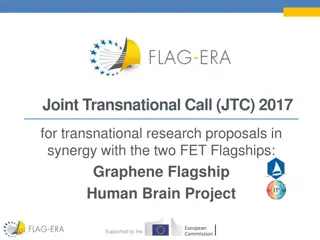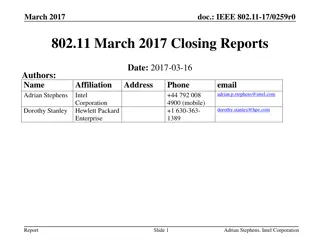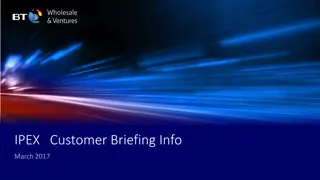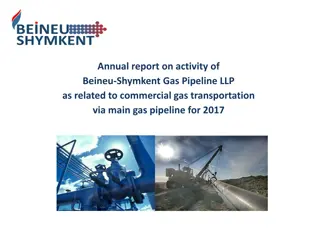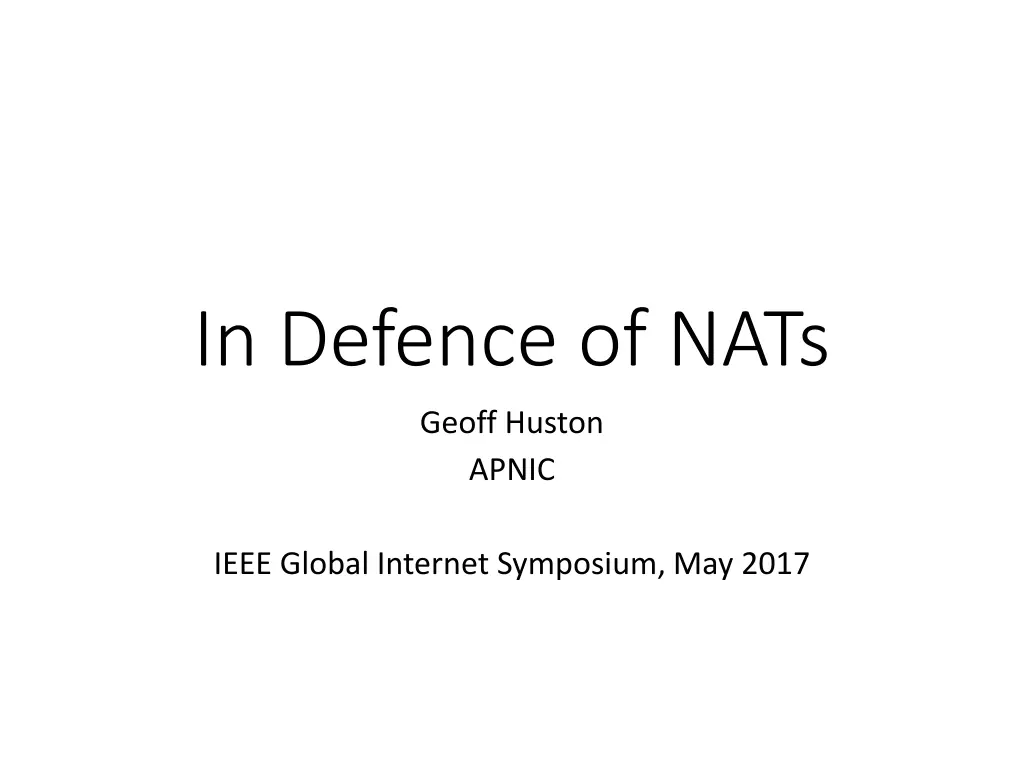
Evolution of Internet Architecture: NATs, IP Strengths, and Consequences
Explore the evolution of internet architecture through topics such as NATs, the architecture of the 1990 internet, IP strengths, and their consequences. Delve into discussions on data flow, IP addresses as unique identifiers, and the decoupling of end-to-end transport and hop-by-hop forwarding. Gain insights from the Proceedings of the 18th IETF Meeting in August 1990 on internet growth.
Download Presentation

Please find below an Image/Link to download the presentation.
The content on the website is provided AS IS for your information and personal use only. It may not be sold, licensed, or shared on other websites without obtaining consent from the author. If you encounter any issues during the download, it is possible that the publisher has removed the file from their server.
You are allowed to download the files provided on this website for personal or commercial use, subject to the condition that they are used lawfully. All files are the property of their respective owners.
The content on the website is provided AS IS for your information and personal use only. It may not be sold, licensed, or shared on other websites without obtaining consent from the author.
E N D
Presentation Transcript
In Defence of NATs Geoff Huston APNIC IEEE Global Internet Symposium, May 2017
The Architecture of the 1990 Internet Dumb Network, Smart Hosts Remove all the functionality from the network apart from forwarding and buffering Place all the responsibility for data flow integrity and control into the end host protocol stacks
The Architecture of the 1990 Internet Each IP header carries sufficient information to enable a network of stateless forwarders to pass a packet to its intended destination IHL Total Length Version Type of Service Identification Flags Fragment Offset Protocol Time To Live Header Checksum Source Address Destination Address Options Padding
Data Flow Application Application Process to Process Transport Transport Host to Host Internet Internet Internet Internet Internet Link Link Link Link Link The intention was that only the IP header is used by the network, and the entire remainder of the packet, including the transport headers, is an opaque payload Each packet can be forwarded (optionally fragmented) or discarded
IPs Strengths There is no setup and tear down of network state There is no requirement for symmetry between forward and reverse packet flows While it is preferred that the network maintain the order of packets, it s not a strict requirement End-to-End Transport and Hop-by-Hop Forwarding are decoupled: the end-to-end transport protocol is a host choice, not a network choice
Consequences IP addresses are globally significant unique identifiers they are not local virtual circuit identifiers All IP routers need to be aware of the relative location of all active IP addresses The total capacity of the network is limited by the number of IP addresses and the ability to represent the relative location of all these addresses within every router
Proceedings of the 18th IETF Meeting August 1990 Internet Growth Frank Solensky, Proc. IETF, Aug 1990
Proceedings of the 18th IETF Meeting Internet Growth Frank Solensky, Proc. IETF, Aug 1990
Address Classes Each IP address has a network part and a host part The original IPv4 address plan divided the IPv4 address pool into three Classes https://en.wikipedia.org/wiki/Classful_network
Removing Classes The problem was not that we were running out of addresses The problem was that we were running out of Class B addresses The adopted solution was to keep the implicit routing aggregation of the network / host division of addresses, but carry the network/host division point with the address prefix E.g. 192.0.2.0/24 Length of network prefix in bits
Pre-CIDR Routing Table Growth CIDR Worked! Post-CIDR Routing Table Growth March 1994 deployment of CIDR in BGP-4
Buying Time was just a stopgap measure The underlying issue was the personal computer, which dramatically increased the numbers of connected devices and indirectly fueled the first wave of commercialization of the Internet And this was not going to stop laptops, the mobile devices all added to the numbers of connected devices The thinking at the time was to change as little as possible, so we thought that enlarging the address fields of the IP header would be sufficient to meet this challenge to scaling The answer that was adopted by the IETF was IPv6
The origins of IPv6 IPv6 represented a minimal change to IPv4 Some aspects of IP were changed: Expanded address fields Altered fragmentation controls Re-formatted options and control fields Much was unaltered: UDP and TCP transport protocol behaviour Hop-by-hop destination-based datagram forwarding And some was unspecified: IPv6 Address Plan
There were many other ideas that were aired at the time And one of them was a mechanism for address sharing
Address Sharing NAT PublicAddress Realm Private Address Realm
Port-Translating NATs Version IHL Total Length Type of Service Identification Flags Fragment Offset Header Checksum IP Header Time To Live Protocol = 6 Source Address Destination Address Options Padding Source Port Destination Port TCP Sequence Number Acknowledgment Number F IN N G K H T Checksum S Y U R A C P S R S Data offset Window Urgent Pointer Padding TCP Options TCP Data These NATs allow address sharing by using the transport protocol s port fields as part of the address distinguisher
NAT Binding table Source Address/Port + Dest Address/Port Source Address/Port + Dest Address/Port Inside Outside NATs take the 96-bit 4-tuple of Protocol+Address+Ports and replace the packet s fields that match one side of the binding table with the fields on the other side Outbound packets that do not match any binding table generate a new table entry Inbound packets are discarded
NATs: Enforce symmetric network paths Require session state within the network Enforce Client / Server architecture Create fragility in the network Violate layer integrity Motivate the use of proxies and gateways Prevent innovation in transport services Handle UDP bindings inconsistently
NATs are Evil! These considerations led to a long held mantra in the IETF that NATS are evil and the IETF refused to work on standardizing NAT behaviour for many years The consequence was that NATs were developed with idiosyncratic behaviours, particularly in relation to UDP-based binding Which led to all kinds of convoluted application level behaviours to discover and adapt to the NATs in the path (STUN, TURN, ICE, TEREDO, )
NATs run todays Internet 2.8B advertised IPv4 Addresses 25B connected devices * The average address sharing ratio appears to be 10:1 NATs are everywhere! * https://www.statista.com/statistics/471264/iot-number-of-connected-devices-worldwide/
Why are NATs so pervasive? They are backward compatible with the existing network They allow for uncoordinated piecemeal deployment They impair open peer to peer connectivity and enforce client behaviours behind the NATs They use the port space to enlarge the effective address space
How far can we push NATs? I have 7,000 DSL broadband customers behind it. Peak time throughput is hitting up at 4 gbps... I see a little over 100,000 service flows (translations) at peak time I think each MX104 MS-MIC-16G can able about ~7 million translations and about 7 gbps of cgnat throughput... so I'm good. I have a /25 for each MX104 outside public address pool (so /24 total for both MX104's)... pretty sweet how I use /24 for ~7,000 customers :) Aaron Gould, NANOG, https://mailman.nanog.org/pipermail/nanog/2017-April/090809.html
How far can we push NATs? The NAT binding space is a 96 bits wide 4-tuple Source Address/Port + Dest Address/Port 96 bits Address Compression Ratio 10:1 100:1 1,000:1 >>10,000:1 NAT type: CGN with per user port blocks CGN with per user port blocks + pooled overflow CGN with pooled ports CGN with 4-tuple binding maps
So, in comparison, what does IPv6 offer? Backward Compatibility with IPv4? Nope! More address bits? The current IPv6 address plans typically use a 48 bit end site prefix CGNats potentially push the virtual IPv4 address space to between 42 and 45 bits More flexibility? It is unclear if there is a clear need to shift back to the overloaded location / identifier semantics of addresses as the client / server model is closely aligned to today s Internet Less cost? Well no for as long as IPv4 remains the dominant protocol then the Internet needs to support IPv4, which implies the use of NATs. It is IPv6 that is the discretionary expenditure item for many service providers
NATs are under-appreciated! For some time now we have been contemplating what it means to have a name-based data network, where instead of using a fixed relationship between names and IP addresses, we eschew this mapping and perform network transactions by specifying the name of the desired service or resource
NATs are under-appreciated! NATs are an interesting step in this direction, where IP addresses have lost their static association with particular endpoints, and are used more as ephemeral session tokens than endpoint locators.
NATs are under-appreciated! This certainly appears to be an interesting step in the direction of named data networking where addresses lose any permanent association with endpoint identity, and retain only the fixed semantics of a network locator used in routing
In Defence of NATs It is NATs that have kept the Internet running for the past decade In that time the network has grown from around 2B connected devices to ten times that number The IPv4 network and its application suite is now built on the assumption of pervasive use of NATs These same application and service design parameters are used in the context of IPv6
IPv6 Addresses Do we use fixed end addresses in IPv6 anyway? Well, no, not all the time! Clients typically use privacy addresses that use a random 64 bit interface identifier So the IPv6 IP end address is now ephemeral for clients Services are increasingly using name based hosting There are more levers and control points in the DNS as distinct from IP anycast So even IPv6 has eschewed fixed end addressing!
NATs in IPv6 For some this is heresy! However: IPv6 has already dissociated itself from fixed end addresses we have already marked off ULAs as private use IPv6 address prefixes (fc00::/7 RFC4193) Persistent private addresses and NATs avoid forced site renumbering NATs allow site multi-homing without route de-aggregation NATs obscure internal site network details and enforce client obscurity As IPv6 gathers momentum it may be the case that network admins will use ULA prefixes plus NATs to re- create the IPv4 NAT architecture in IPv6
In Defence of NATS Maintaining a network infrastructure that uniquely names and numbers every attached device has proved to be economically infeasible in the Internet NATs segment the device population into clients and servers - Clients are not uniquely named, nor uniquely addressed We may not have planned it this way, but undeniably what keeps today s Internet running as a single cost effective network is NATs.
NATs as part of the Architecture NATs have pushed the network into a mode where IP addresses are ephemeral conversation tokens without lasting significance as an endpoint identifier For clients, address uniqueness is a locally scoped property, rather than a globally scoped attribute Some services still use unique addresses Other services use generic aggregate addresses and relay on the application to perform service identification
Todays Internet Architecture Is this the model of disambiguation of location and service identity that we ve been searching for for the past couple of decades? Are we over a model of networking where addresses uniquely denote points of attachment to a common network? Are addresses locally scoped elements that provides disambiguation only to the extent that they are necessary?










